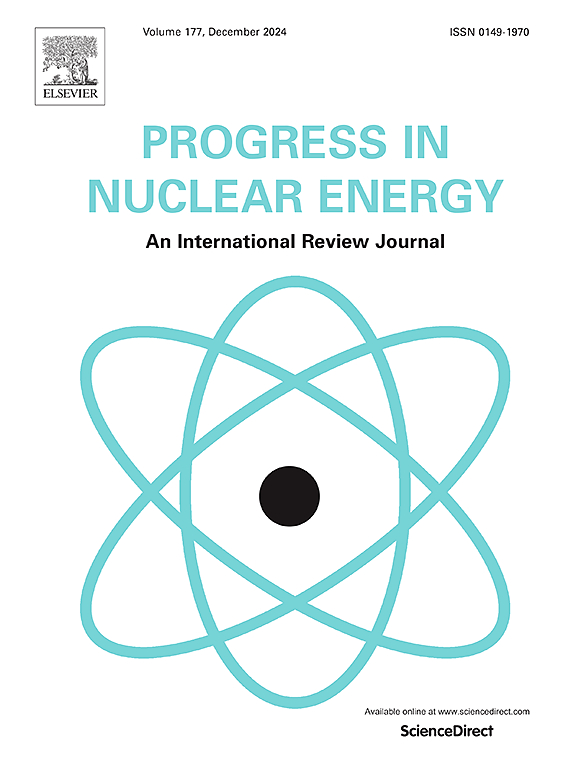圆柱形浮动核动力平台水动力特性实验研究与数值模拟
IF 3.2
3区 工程技术
Q1 NUCLEAR SCIENCE & TECHNOLOGY
引用次数: 0
摘要
为了支持岛礁开发的综合需求和区域经济增长,圆柱形浮动核电平台具有固有安全性、使用寿命长、环境适应性强等特点,是理想的解决方案。然而,复杂的海洋环境,以多变的风、浪和洋流为特征,可能会引起平台的振荡,从而危及设备的安全运行。为了确保在这种条件下的反应堆安全,对一系列海洋情景下的圆柱形浮动核电平台进行安全分析是必不可少的。虽然以前的研究主要集中在船形平台上,但针对圆柱形平台及其反应堆系统的研究仍然有限。此外,许多现有的小规模实验研究忽略了系泊系统对动力响应的影响,未能分析风、浪、流联合条件下的横摇运动和结构安全性,导致与实际性能有较大偏差。在本研究中,对附加质量和附加阻尼的仿真模型进行了校正,误差小于4%。分析了一个圆柱形浮动核平台在极端工况下的动力响应,确定了该压力容器的最大Von Mises应力为17.34 MPa。这些研究结果进一步验证了该平台的可行性,并为其安全设计提供了参考。本文章由计算机程序翻译,如有差异,请以英文原文为准。
Experimental study and numerical simulation on hydro-dynamic characteristics of cylindrical floating nuclear power platform
To support the comprehensive needs of island and reef development, as well as regional economic growth, the cylindrical floating nuclear power platform is an ideal solution due to its inherent safety, long service life, and strong environmental adaptability. However, the complex marine environment, characterized by variable wind, waves, and currents, can induce platform oscillations that may compromise the safe operation of the equipment. To ensure reactor safety under such conditions, conducting safety analyses of cylindrical floating nuclear power platforms across a range of marine scenarios is essential. While previous research has predominantly focused on ship-shaped platforms, studies targeting cylindrical platforms and their reactor systems remain limited. Moreover, many existing small-scale experimental studies neglect the impact of mooring systems on dynamic responses and fail to analyze roll motion and structural safety under combined wind, wave, and current conditions, leading to considerable deviation from real-world performance. In this study, a simulation model for added mass and added damping is calibrated with an error of less than 4 %. The dynamic response of a cylindrical floating nuclear platform under extreme operating conditions is analyzed, and the maximum Von Mises stress of the pressure vessel is determined to be 17.34 MPa. These findings further validate the platform's feasibility and offer a reference for its safety-oriented design.
求助全文
通过发布文献求助,成功后即可免费获取论文全文。
去求助
来源期刊

Progress in Nuclear Energy
工程技术-核科学技术
CiteScore
5.30
自引率
14.80%
发文量
331
审稿时长
3.5 months
期刊介绍:
Progress in Nuclear Energy is an international review journal covering all aspects of nuclear science and engineering. In keeping with the maturity of nuclear power, articles on safety, siting and environmental problems are encouraged, as are those associated with economics and fuel management. However, basic physics and engineering will remain an important aspect of the editorial policy. Articles published are either of a review nature or present new material in more depth. They are aimed at researchers and technically-oriented managers working in the nuclear energy field.
Please note the following:
1) PNE seeks high quality research papers which are medium to long in length. Short research papers should be submitted to the journal Annals in Nuclear Energy.
2) PNE reserves the right to reject papers which are based solely on routine application of computer codes used to produce reactor designs or explain existing reactor phenomena. Such papers, although worthy, are best left as laboratory reports whereas Progress in Nuclear Energy seeks papers of originality, which are archival in nature, in the fields of mathematical and experimental nuclear technology, including fission, fusion (blanket physics, radiation damage), safety, materials aspects, economics, etc.
3) Review papers, which may occasionally be invited, are particularly sought by the journal in these fields.
 求助内容:
求助内容: 应助结果提醒方式:
应助结果提醒方式:


